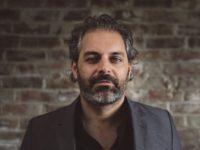by S. Victor Aaron
Orchestral jazz seem to be a dying art these days. Oh sure, there are Ellington, Monk and Mingus tribute bands, but there seems to be a dearth of composers creating new works. Well OK, maybe that’s a little dramatic. In reality, such jazz composers still do exist today, but they toil in relative obscurity. One of the more notable contributors to the under-appreciated art of classical jazz among contemporaries was Paul Nash.
Paul Nash was a jazz guitarist who studied classical composition and from early on in his career concentrated on composing for and leading large ensembles. Shortly after he completed his studies in composition in the San Francisco Bay Area, Nash stuck around the area and founded the Paul Nash Ensemble in 1977, later establishing other jazz orchestras. The young, budding talents of trumpeters Mark Isham and Tom Harrell as well as future Spyro Gyra vibe player Dave Samuels have cut their teeth playing in Nash-led groups before making their own marks on the jazz world.
Eventually, Nash moved back to his native New York City in 1990, where he launched another vehicle for his compositions, the Manhattan New Music Project. Over the years MNMP has played in venues around NYC, presenting the music of Nash of other modern creative composers from the USA and around the globe. Prior to Jazz Cycles, they had put out just two albums, Mood Swing and The Soul Of Grace.
You might be wondering why I write of Paul Nash in the past tense. In 2003 while in his mid-fifties, Nash was diagnosed with terminal brain cancer. He met this challenge with a determination to create a last flurry of compositions before his impending death to be recorded by the MNMP. The ensemble convened in the studio on December 6, 2004 and in a live-in-the-studio six hour session of only two takes, knocked out the fourteen tracks that make up this CD. The following day, during mixing, Nash fell ill and had to be brought straight to the hospital from the studio. He died there six weeks later.
The seven-piece band that came into the studio for Nash’s last hurrah consisted of Shane Endsley on trumpet, Bruce Williamson on alto and soprano saxes, Tim Ries on tenor saxes, Vic Juris on guitar, Jay Anderson on bass, Grisha Alexiev on drums and Jim Ridl on piano. Juris, the guitarist who played alongside Mike Stern on Dave Liebman’s Back On The Corner, displays a decidedly more John Scofield-like tone on this set. Jay Anderson, late of David Witham’s Spinning The Circle provdes his accurate acoustic bass services for MNMP as well.
And as for the record itself, it’s clear these guys were giving it their all for their ailing leader. There’s no wrong note that I could detect, it all sounds as if they’ve worked with this material for weeks. And the material itself is no cakewalk; Nash changes tempo, time signatures and styles frequently. It’s not a terribly difficult listen and consists of a lot of pretty passages, but consistent with the classical aspect of it, the pieces are demanding of the musicians’ attention to detail. The array of moods and modes encompassed by this single collection also suggests that Nash wanted to take a look back at his career and the various styles he touched upon along the way.
The first two tracks are fine examples of Nash’s talent for intertwining interesting song structures and improvisional space. “Passaglias” gets going with a line played as an ostinato by Juris and then a countering line by Reis. The horns as a whole augment the counter line and then the meldoy shifts, opening the way for a passionate alto solo by Williamson. Just as Williamson reaches his climatic note, the song segues into the staccato-filled “Night Flight”, and Alexiev’s drums provide the backdrop for soloing by Endsley, then Anderson, and finally, Juris and Ries.
The deeply lyrical “Desire” follows, reminiscent of Herbie Hancock’s best ballad pieces of his classic Blue Note days, with Endsley’s muted horn setting a meloncholy mood. “Wind Over The Lake” begins with dissonaant figures before settling into a repeating melody and pulsating rhythm. Ridl provides some interesting, angular piano lines in the solo break.
Other notable tracks include group improvisional “Strange Rife,” the funky, shifting “Outside In” and the straightforward, hard swing of “It’s Only a Dream.” The album wraps up with a longer reprise of “Night Flight”, which sounds more expressive and softer than the former version. Ridl provides a particularly inspired solo for this go around. A brief, energetic epilogue follows, as if to be saying goodbye on a upbeat note.
When Nash first learned of his impending demise, he wrote “My life has been given sudden definition, an end point that I can almost prepare for, at once frightening and magnificent…”. With Jazz Cycles, Nash clearly greeted the news as an opportunity to produce one last great set of works with the clock running out. He wasn’t merely inspired to create enough material for one CD on such short notice; a second CD containing more of his final musical statements is still forthcoming after this one. Paul Nash is gone, but his music is very much fresh and alive.
Jazz Cycles will be available in stores October 2.
- Nick Millevoi – ‘Moon Pulses’ (2024) - April 23, 2024
- Cannonball Adderley – ‘Poppin’ in Paris: Live at L’Olympia 1972′ (2024) - April 20, 2024
- Christian Marien Quartett – ‘How Long Is Now’ (2024) - April 18, 2024




